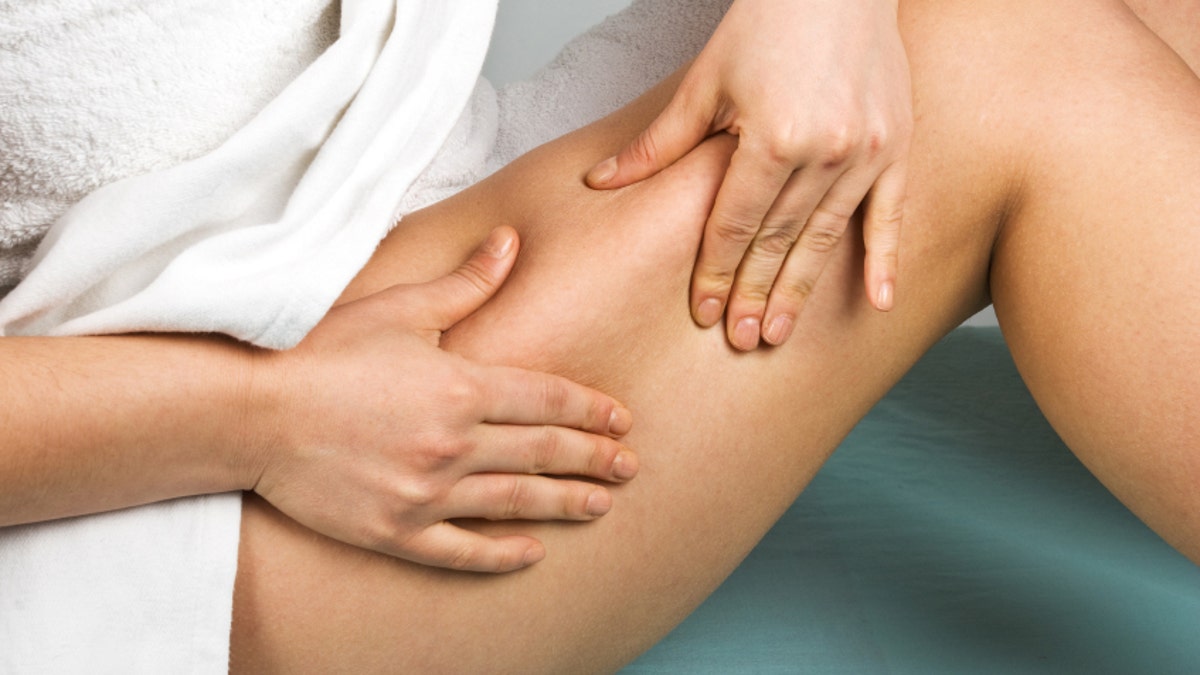
The truth behind commonly held beauty beliefs.
Myth 1: Crossing your legs will give you varicose veins.
Sitting down and crossing your legs won't cause varicose or spider veins, but standing may. Pronounced veins often crop up on people who either have a genetic predisposition to them or have jobs that require them to stand a lot, says Kevin Pinski, a dermatologist in Chicago.
Standing makes the vascular network work extra hard to pump blood from the legs up to the heart. If the valves, which keep blood flowing in one direction within your vessels, aren't functioning properly, a pooling of blood can occur and result in unsightly veins. Pregnancy, which puts added pressure on the circulatory system, or a trauma―getting hit by a softball or a car door, for example―can also lead to varicose or spider veins.
[sidebar]
Myth 2: You can get rid of cellulite.
Ah, if only. "This remains one of the holy grails of cosmetic dermatology," says Timothy Flynn, a clinical professor of dermatology at the University of North Carolina at Chapel Hill School of Medicine. Nothing can be done to permanently eliminate it―not even liposuction. Cellulite consists of fat deposits that get trapped between the fibrous bands that connect the skin's tissues.
The bands squeeze the fat under the skin, resulting in a lumpy texture. Luck of the gene pool mostly determines who will and won't get cellulite. It doesn't matter whether you're fat or thin. You can, however, temporarily reduce its orange peel-like appearance. Firming creams often contain caffeine to tighten and smooth the skin. But a basic moisturizer will also work to hydrate and swell the skin, making cellulite a little less obvious. Or try using a self-tanner.
"A fake tan will help camouflage it," says Elizabeth Tanzi, a dermatologist and a codirector of laser surgery at the Washington Institute of Dermatologic Laser Surgery, in Washington, D.C.
Myth 3: Shaving will make your hair grow back darker and thicker.
"Hair that hasn't been cut grows to a point," says Heather Woolery-Lloyd, a dermatologist in Miami. "It's widest at the base and narrowest at the tip." When you shave a hair, you cut it at the base. The widest part then grows out, and the hair appears thicker. But shaving doesn't change the width, density, or color of hair.
Myth 4: Putting Vaseline on your face nightly will prevent wrinkles.
Marilyn Monroe allegedly slathered the thick salve on religiously to stay youthful-looking, but that doesn't mean you should. "Petroleum jelly is the strongest moisturizer there is because it forces oils into the skin and prevents them from evaporating," says Paul Jarrod Frank, a dermatologist in New York City. As the skin ages, it loses its ability to retain moisture, and skin that's dry looks older.
"Petroleum jelly can make wrinkles less apparent because it's adding moisture to the skin, which softens lines, but it can't actually prevent aging," Pinski says. Only a cream with a proven active ingredient, such as retinol, can stave off wrinkles. Plus, petroleum jelly is so greasy that it can create other problems, including breakouts.
Myth 5: If you use wax to remove hair, fewer hairs will grow back.
"Wax rips the hair out at the follicles," explains Woolery-Lloyd. "And any repeated injury to the follicles over time―we're talking 20 years―could damage some follicles to the point that they don't grow back." So employ waxing for its ability to keep your legs smoother longer than shaving can, not for diminishing hair growth.
Myth 6: Preparation H deflates puffiness.
This is a secret of makeup artists everywhere, and there's a lot of anecdotal evidence to suggest that this hemorrhoid cream can reduce undereye baggage, but no clinical studies have been done.
One of the product's ingredients, a yeast derivative that is said to reduce puffiness, is no longer found in the version that's available in the U.S. (The cream was reformulated in 1994.) The other ingredient that is credited with reducing inflammation is phenylephrine, which temporarily constricts blood vessels. Nevertheless, using Preparation H around the eyes can cause dry and inflamed skin, says McBurney, so use this only where it's meant to be used, south of the belt line.
Myth 7: Rubbing your eyes creates wrinkles.
You won't get crow's-feet just from kneading your eyes when you're tired, says Frank. But the tug of gravity and the repetitive movement of facial muscles, as in smiling or frowning, can break down the collagen in your skin and create wrinkles over time. So that silly taunt you heard as a child―"If you keep making that face, it will freeze that way"―has merit.
Myth 8: Applying cocoa butter or olive oil will stop stretch marks.
Sadly, this isn't true. Stretch marks occur when skin expands quickly (as in pregnancy), breaking the collagen and elastin fibers that normally support it. Or they're simply luck of the genetic draw. "Stretch marks are formed below the top layer of skin, where the cocoa butter and olive oil can't reach," says McBurney. The most either can do is quell the itching that occurs when skin expands.
Myth 9: Brushing your hair 100 strokes a day will make it shine.
Marcia Brady, it turns out, was overzealous in her beauty routine. "One hundred strokes is too much," says Christopher Mackin, a trichologist (someone who studies hair) at the Gil Ferrer Salon, in New York City.
"You'll do more damage than good." Hair will break if you tug on it too much. However, gentle brushing―a few strokes here and there―will make hair shine by distributing the natural oils from the scalp down the hair shafts and flattening the cuticles to make them reflect more light. More significant, light brushing removes impurities and stimulates blood flow to the scalp, which nourishes hair follicles and keeps them healthy.
